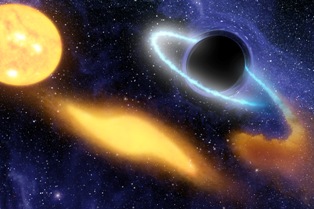

Early Bird Gets the Worm
or "Black Hole Breakfast"
by Dr. Tony Phillips
We all know that birds eat worms. Every day, millions of birds eat millions of worms. It’s going on all around you! But how often have you awakened in the morning, stalked out in the dewy grass, and actually seen a bird having breakfast? Even though we know it happens all the time, a bird gulping a worm is a rare sight.
Just like a black hole gulping a star…
Every day in the Universe, millions of stars fall into millions of black holes. And that’s bad news for the stars. Black holes exert terrible tides, and stars that come too close are literally ripped apart as they fall into the gullet of the monster. A long burp of X-rays and ultraviolet radiation signals the meal for all to see.
Yet astronomers rarely catch a black hole in the act. "It’s like the problem of the bird and the worm," says astronomer Christopher Martin of Caltech. "You have to be in the right place at the right time, looking in the right direction and paying attention."
A great place to look is deep in the cores of galaxies. Most galaxies have massive black holes sitting in their pinwheel centers, with dense swarms of stars all around. An occasional meal is inevitable.
A group of astronomers led by Suvi Gezari of Caltech recently surveyed more than 10,000 galactic cores—and they caught one! In a distant, unnamed elliptical galaxy, a star fell into a central black hole and "burped" a blast of ultraviolet radiation.
"We detected the blast using the Galaxy Evolution Explorer (GALEX), an ultraviolet space telescope," explains Gezari. Her team reported the observation in the December 2006 issue of The Astrophysical Journal Letters. "Other telescopes have seen black holes devouring stars before," she adds, "but this is the first time we have been able to watch the process from beginning to end."
The meal began about two years ago. After the initial blast, radiation diminished as the black hole slowly consumed the star. GALEX has monitored the process throughout. Additional data from the Chandra X-ray Observatory, the Canada-France-Hawaii Telescope and the Keck Telescope in Hawaii helped Gezari’s team chronicle the event in multiple wavelengths
Studying the process in its entirety “helps us understand how black holes feed and grow in their host galaxies,” notes Martin.One down, millions to go.
"Now that we know we can observe these events with ultraviolet light,” says Gezari, “we've got a new tool for finding more."
For more on this and other findings of GALEX, see www.galex.caltech.edu. For help explaining black holes to kids, visit The Space Place at spaceplace.nasa.gov.
In this artist’s concept, a giant black hole is caught devouring a star that ventured too close.
This article was provided by the Jet Propulsion Laboratory, California Institute of Technology, under a contract with the National Aeronautics and Space Administration.
All content is the responsibility of LUNAR.
If you have comments or suggestions regarding these web pages,
please contact the 
Copyright © 1992 - 2025 LUNAR